December 3, 2016
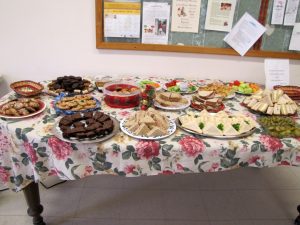 Lunch is always on offer prior to our meetings. Some folks are asked to contribute a dish, and others pay a nominal fee (probably the cheapest lunch in town!) for a varied array of sandwiches, cookies and squares, and other tasty foods.
Lunch is always on offer prior to our meetings. Some folks are asked to contribute a dish, and others pay a nominal fee (probably the cheapest lunch in town!) for a varied array of sandwiches, cookies and squares, and other tasty foods.
Across the lunch table we can talk about our ancestors or our descendants. People offer suggestions to those still collecting the information required to complete an application to be certified as a Loyalist descendant, Some discover, to their surprise, that their great-great-grandfather was the brother of someone else’s great-great-great-grandmother: it has happened several times!
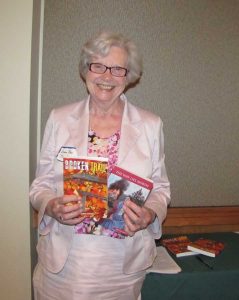 Our speaker was author Jean Rae Baxter, on “Honouring Loyalist History Through Fiction”. Ms. Baxter has published numerous award-winning historical novels, many based on events from the American Revolution. She kindly brought a supply of her books which were eagerly purchased by members, both for themselves and to give as gifts for Christmas – an ideal way to interest a grandchild in Loyalist history.
Our speaker was author Jean Rae Baxter, on “Honouring Loyalist History Through Fiction”. Ms. Baxter has published numerous award-winning historical novels, many based on events from the American Revolution. She kindly brought a supply of her books which were eagerly purchased by members, both for themselves and to give as gifts for Christmas – an ideal way to interest a grandchild in Loyalist history.
Jean Rae had been asked to add some pointers in her talk that the members might be able to use when writing up their own family histories. How could we make them more interesting to strangers who may be reading them on our website next year, when we complete our “Canada 150” goal of collecting 150 stories about Loyalists on our website and possibly in a book? Jean Rae gave us a brief writing workshop that was both comprehensive and succinct, using esamples from her own writing to illustrate her points. Before we start to write, she said, we should set out three statements:
- I want to write about…
- I want to show …
- I want the reader to experience…
Jean Rae went on to point out that we need to set events in specific place and time. We need to ensure that our story has a beginning, middle and end: don’t start telling the reader about John Jones’ service in the Kings’ Royal Rangers without expanding on where they fought and where he ended up.
We hope to receive 150 articles that put Jean Rae’s excellent writing advice to use.
This was also our Annual General Meeting. People were sought for unfilled executive positions, but unfortunately we continue to have vacancies. Those already on the executive were acclaimed to remain in the positions they are presently holding. Members are encouraged to volunteer through the coming year to help with Program and Newsletter. Looking ahead, we also need people willing to “shadow” the positions of Treasurer and even President, to begin learning what responsibilities are entailed in each role.
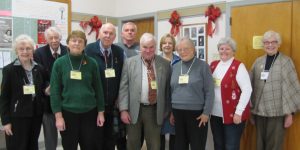
Left to right: Audrey Bailey, Chard fund trustee; Gerry Roney, treasurer; Maureen Long, hospitality coordinator; Dean Taylor, past president; Jim Long, house coordinator and Chard trustee; Peter Milliken, president and Chard fund trustee; Anne Redish, branch genealogist and South-East Region Vice-President UELAC; Nancy Cutway, communications coordinator and webmaster; Lorraine Sherren, membership coordinator; Jean Rae Baxter, speaker. Absent: Loralee Martin, secretary.
September 24, 2016
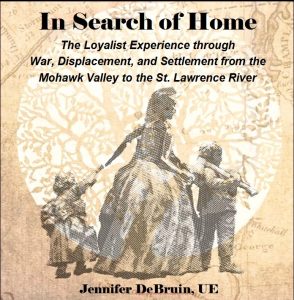 A good number of members and several visitors came to hear Jennifer DeBruin UE whose topic was “In Search of “Home” – The Loyalist Experience through War, Displacement, and Settlement from the Mohawk Valley to the St. Lawrence River”.
A good number of members and several visitors came to hear Jennifer DeBruin UE whose topic was “In Search of “Home” – The Loyalist Experience through War, Displacement, and Settlement from the Mohawk Valley to the St. Lawrence River”.
Jennifer is descended from several Loyalist families who originally lived in the Mohawk Valley, among them Eamer and Alguire. Though the menfolk served in both the 1st and 2nd Battalions of the King’s Royal Regiment of New York (KRRNY), Jennifer explained that her 2nd Battalion ancestors chose to settle along the St. Lawrence near Cornwall, Ontario, rather than with the majority of the 2nd Battalion who lived in the Bay of Quinte region. This was done so they could be close to their once neighbours and family of the Mohawk Valley.
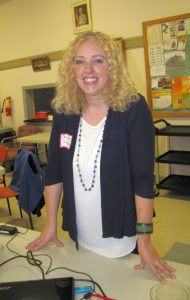 The women, meanwhile, carried on as best they could during the war, looking after their children, animals, and properties. After the Revolution ended, when they were ordered to vacate their homes, many travelled to Canada along the waterways, but some crossed the Adirondack Mountains often without their menfolk along to help. Rather, they followed those sent to rescue them, which were often allied Mohawk guides.
The women, meanwhile, carried on as best they could during the war, looking after their children, animals, and properties. After the Revolution ended, when they were ordered to vacate their homes, many travelled to Canada along the waterways, but some crossed the Adirondack Mountains often without their menfolk along to help. Rather, they followed those sent to rescue them, which were often allied Mohawk guides.
In June, Jennifer attended the Second Annual Conference on The American Revolution in the Mohawk Valley, organized by the Fort Plain Museum and held at Fulton Montgomery Community College. The speakers and tours provided an opportunity for Jennifer to learn how the Revolutionary War progressed in the Mohawk Valley, and to see where her ancestors lived. She learned, for instance, that on May 19, 1776 Sir John Johnson and 170 of his tenant farmers and friends escaped from Patriot troops coming to arrest Sir John. They escaped in the night, making their way north to Quebec, where Sir John raised the KRRNY, which later returned to the valley and other regions to fight the “rebels”. Among these battles was the “Burning of the Valleys.” In October 1780, the Loyalist regiments were determined to not only rescue Loyalist families, but ensure those of the patriot cause would be unable to sustain themselves in the valley. The goal was to burn the crops and homes of the “rebels” and leave the valley smoldering, a tactic used by the Americans against the Loyalist families as well. Johnson Hall at Johnstown was not burned because it had been commandeered by the Patriots for use as their headquarters. (The Guy Johnson Manor also escaped the fires, but was very badly damaged by Hurricane Irene in 2011 and though now being restored, appears it will not be open to the public in the future, rather being used by NY State for offices.)
The Palatine (Lutheran) Church was built in 1770 between Nelliston and St. Johnsville, New York. It is one of the few pre-Revolution buildings remaining, as most others disappeared after the Burning of the Valleys. It is now on the US National Register of Historic Places.
Jennifer also visited Fort Klock where there is a “fortified house” — not a real fort, but the house had deep stone walls with gun slits for shooting out from the house, once the windows had been sealed with thick wooden interior shutters. Water was brought right into the basement from a nearby creek so that families could barricade themselves in the house for weeks at a time. This is where area families sheltered during the Burning of the Valleys campaign.
Other places of significance to Loyalist history in the area she toured were the Oriskany Battlefield and Fort Stanwix, both in Rome, New York.
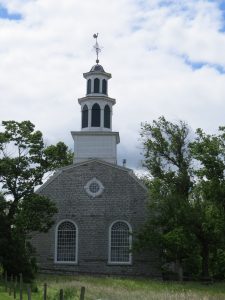 Jennifer pointed out that when the Loyalists came to Canada, the refugees were not welcomed by the local population. Whether they settled in Nova Scotia or camped in tents at places such as Sorel, Quebec, the settlers already there were afraid the incomers would take their jobs or get better land. Though the American Revolution officially ended on September 3, 1783, with the signing of the Treaty of Paris, it wasn’t until early 1784 that land had finally been surveyed for the permanent settlement of the Loyalist refugees. Jennifer’s German Palatine and Scottish Loyalist ancestors went west to settle in what is now known as Stormont, Dundas, and Glengarry (SD&G) Counties, along the St. Lawrence River.
Jennifer pointed out that when the Loyalists came to Canada, the refugees were not welcomed by the local population. Whether they settled in Nova Scotia or camped in tents at places such as Sorel, Quebec, the settlers already there were afraid the incomers would take their jobs or get better land. Though the American Revolution officially ended on September 3, 1783, with the signing of the Treaty of Paris, it wasn’t until early 1784 that land had finally been surveyed for the permanent settlement of the Loyalist refugees. Jennifer’s German Palatine and Scottish Loyalist ancestors went west to settle in what is now known as Stormont, Dundas, and Glengarry (SD&G) Counties, along the St. Lawrence River.
Palatine Church built 1770. Photo courtesy Jennifer DeBruin
The Loyalist families were not done with war yet. During the War of 1812, the Americans set their sights on Canada. By 1813, capturing Montreal became their objective as it would effectively cut the country in half, thereby weakening the ability of Canada to repel their advances. One skirmish of t his campaign happened on November 10, 1813 at Hoople’s Creek near Morrisburg. The Americans moving east were hoping to seize the ammunition stores in Cornwall, but as they made their way overland they were ambushed by 300 men of various SD&G militia units. Though the militia did not win the exchange — Jennifer’s loyal ancestor, Peter Eamer, being one of two wounded in the fight — the skirmish did delay the Americans moving forward. This delay provided enough time to load 150 wagons with the ammunition at Cornwall, which were then transported safely to Coteau-du-Lac, and out of reach of the Americans. The next day, the more famous Battle of Crysler’s Farm was fought. Thousands met in conflict upon this farmland turned battlefield near Morrisburg.
Finally, Jennifer showed some photos from the Lost Villages, six villages and three hamlets housing 6,500 people that were destroyed for the building of the St. Lawrence Seaway in 1958. Many of the villages had been founded by the Loyalists as part of the settlements of 1784. A few tombstones were moved to Upper Canada Village, but the graves of the King’s Royal Regiment of New York now lie under water, and their descendants once again had to find new homes.
NOTE: Jennifer mentioned there is much written about Sir John Johnson which may help those whose ancestors lived in the Valley and perhaps worked on the Johnson estates to find information about their own families. Jennifer referenced finding a 1916 thesis from the University of Illinois about Sir John online. An earlier published book, Orderly book of Sir John Johnson during the Oriskany Campaign, 1776-1777 (Albany, J. Munsell’s Sons; 1882) sounds like it might contain names of soldiers who fought under him. Copies are available at Queen’s University and in numerous libraries around North America.
June 15, 2016
In honour of Loyalist Day in Kingston, which we had celebrated on June 12th (see photos of the flag-raising at City Hall here), plus First Capital Day which is celebrated on June 15th, we held our annual Banquet as a luncheon at Minos Village Restaurant in Kingston.
We were honoured by a visit from Barb Andrew UE, Dominion President of the United Empire Loyalists’ Association of Canada. Barb brought greetings from UELAC and spoke briefly about her own Loyalist ancestors who settled in eastern Ontario.
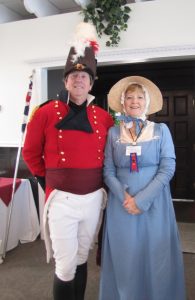
Speaker Dr. Marcus Letourneau encouraged us to think of new avenues to help promote our history and other forms of heritage such as buildings and spaces by putting the stories of people together with those of structures. Several of those present commented that they were now inspired to write up their Loyalist ancestors’ stories.
Several folks attended in costume, bringing lots of colour and interest to their tables. Please view a summary of the Banquet to see other photos.
January 23, 2016
Over 30 of us enjoyed a potluck lunch with hot and cold dishes and yummy squares and cookies. During lunch we had opportunity to look through some of the numerous photograph albums that have been donated to our branch library. A few of our scrapbooks were also brought out for viewing. During the business meeting after lunch, plans for a succession of “work bees” to index the stories in the scrapbooks were outlined and members willing to help signed indicated their availability.
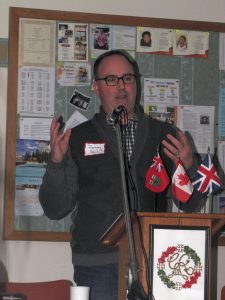 Our speaker, Jeremy Heil is the Digital and Private Collections archivist at Queen’s Archives. He spoke first about Queen’s Archives in general, and the types of documents that fall within their collecting mandate. The Archives holds over 10 km of materials if spread out in a line! There are 3 million photographs, as well as records in other media such as audio and video tapes.
Our speaker, Jeremy Heil is the Digital and Private Collections archivist at Queen’s Archives. He spoke first about Queen’s Archives in general, and the types of documents that fall within their collecting mandate. The Archives holds over 10 km of materials if spread out in a line! There are 3 million photographs, as well as records in other media such as audio and video tapes.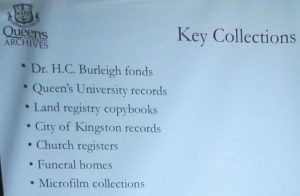
Jeremy then looked at the benefits made possible by digitizing records:
- Scanning fragile material once means that it never has to be handled again and helps preserve it.
- An index can be created that links names to document files.
- The index can be searched easily.
- The documents can be read online by researchers anywhere in the world.
Jeremy used the example of the Burleigh fonds which was digitized for Queen’s Archives by the Internet Archive, a non-profit organization in Toronto. Genealogists looking for UE Loyalists in eastern Ontario appreciate the instant access to Dr. Burleigh’s collection of information on early families. The index to the Burleigh papers is found at http://archives.queensu.ca/search-our-collections/genealogy/dr-hc-burleigh-fonds. When you click on a surname, you are offered a variety of formats for the file.
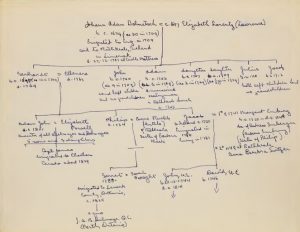 Generally you would select “PDF” and download the file to your own computer, so you can take time looking through it offline. If you choose PDF, you can use Acrobat Reader’s functions to enlarge it on screen. Much of it is handwritten so you will want to enlarge Dr. Burleigh’s writing — see the sample chart from his Dulmage file at the right.
Generally you would select “PDF” and download the file to your own computer, so you can take time looking through it offline. If you choose PDF, you can use Acrobat Reader’s functions to enlarge it on screen. Much of it is handwritten so you will want to enlarge Dr. Burleigh’s writing — see the sample chart from his Dulmage file at the right.
Jeremy also talked about STONES, a project created by Queen’s Archives in 2009. At the website http://www.stoneskingston.ca/ they have multimedia tours of Kingston, focused on different communities: indigenous residents, the francophone community (remember, the French settled at Cataraqui from 1673), prisons, etc. You can listen to the audio tour, download the annotated map to a mobile device, etc. This offers great walking tours for your visitors to Kingston.
Finally, Jeremy outlined details to consider when digitizing your own material:
- if scanning text-based documents, scanning at 300 dpi is sufficient
- when scanning photos, use 600 ppi to make sure you capture enough detail
- when saving photos, use TIFF format which is non-compressed
Jeremy also touched on the need to attach metadata to your scan (that is, when the scan was made, who does it show, etc.). He also reminded us of the need to store our digital records in multiple locations, using an external hard drive and/or the “cloud” as well as on your computer. And once you have digitized your documents and photos, make sure that you store the originals appropriately and safely.
